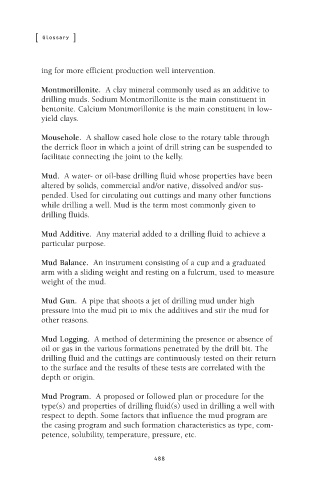Page 512 - Practical Well Planning and Drilling Manual
P. 512
Appendix NEW! revised 11/00/bc 1/30/01 3:30 PM Page 488
[ ]
Glossary
ing for more efficient production well intervention.
Montmorillonite. A clay mineral commonly used as an additive to
drilling muds. Sodium Montmorillonite is the main constituent in
bentonite. Calcium Montmorillonite is the main constituent in low-
yield clays.
Mousehole. A shallow cased hole close to the rotary table through
the derrick floor in which a joint of drill string can be suspended to
facilitate connecting the joint to the kelly.
Mud. A water- or oil-base drilling fluid whose properties have been
altered by solids, commercial and/or native, dissolved and/or sus-
pended. Used for circulating out cuttings and many other functions
while drilling a well. Mud is the term most commonly given to
drilling fluids.
Mud Additive. Any material added to a drilling fluid to achieve a
particular purpose.
Mud Balance. An instrument consisting of a cup and a graduated
arm with a sliding weight and resting on a fulcrum, used to measure
weight of the mud.
Mud Gun. A pipe that shoots a jet of drilling mud under high
pressure into the mud pit to mix the additives and stir the mud for
other reasons.
Mud Logging. A method of determining the presence or absence of
oil or gas in the various formations penetrated by the drill bit. The
drilling fluid and the cuttings are continuously tested on their return
to the surface and the results of these tests are correlated with the
depth or origin.
Mud Program. A proposed or followed plan or procedure for the
type(s) and properties of drilling fluid(s) used in drilling a well with
respect to depth. Some factors that influence the mud program are
the casing program and such formation characteristics as type, com-
petence, solubility, temperature, pressure, etc.
488

